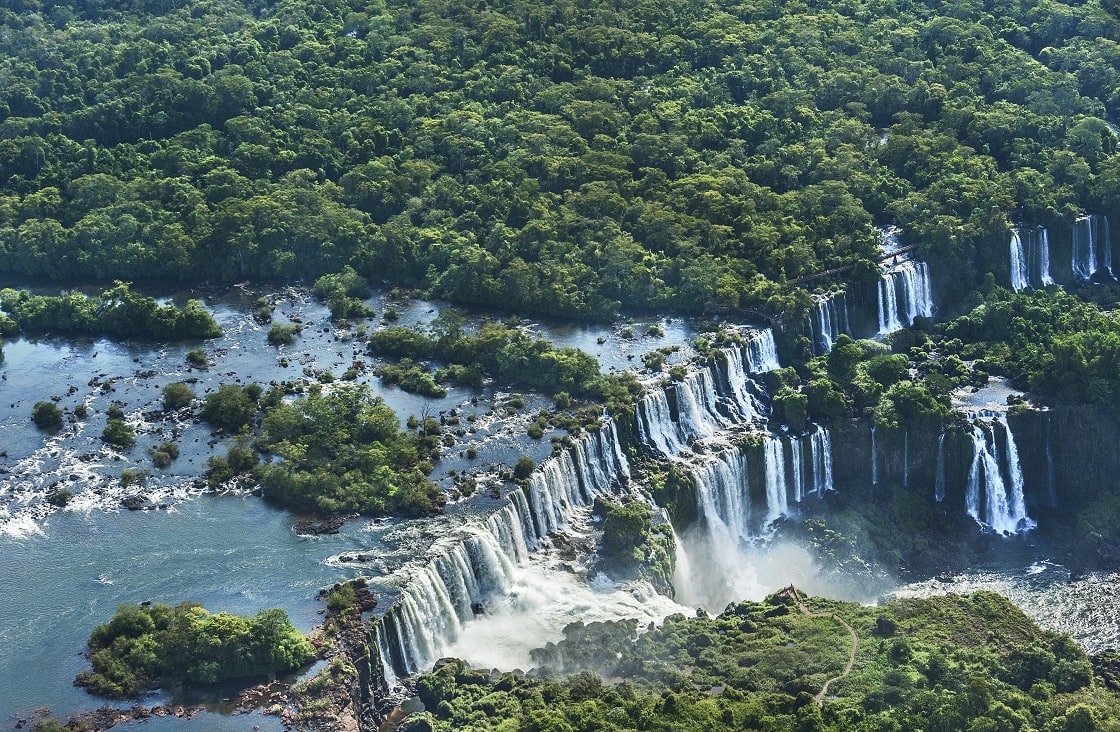
The Iguazu Falls separates Argentina and Brazil along a basalt fault and is widely acknowledged as the world’s most breathtaking complex of waterfalls. Here, a network of over 250 individual cascades carry the Iguazú River over a 200–269-foot drop at the astounding rate of 400,000 gallons per second. Visitors often come on a quick day trip to catch a glimpse of this mind-blowing Natural Wonder Of The World, but there are so many more things to do at Iguazu Falls. Read on for a list of Iguazu Falls activities on both the Brazilian and Argentinian sides.
The first thing to do at the Iguazu Falls is to see the falls up close and personal from the many bridges, boardwalks, and pathways below them. If you take a tour of the falls with a guide you will learn some fascinating facts and information during your visit. Bilingual guides offer services on both the Argentinian and Brazilian sides of the falls.
During five nights every month, Iguazú National Park opens up for visitors to tour the falls by the moonlight and watch the hundreds of cascades on the Argentine side. There are three tours a night, and you will get to ride the train to Garganta del Diablo for a magical experience, listening to the sounds of nocturnal life along the way. You’ll see the falls under the eerily beautiful lighting in a more intimate setting, and if you’re lucky enough, you may even catch a “midnight rainbow” made by the moonlight passing through the mists.
Moonlit bike tours are also available, during which you will be accompanied by a naturalist guide who will help you to appreciate the falls at night while pointing out different types of nocturnal birds and animals native to the area.

Jet Boat At Argentina’s Iguazu Falls
The jetboat safari is the most fun you’ll ever have in rushing water. After a buggy ride through the jungle and a short hike on a rainforest path, you’ll arrive at a calm section of the river where you board a powerful twin-engine jet boat that will travel four miles down the Iguazu River and through the different tiers of the falls, all promising exceptional views of the gorgeous scenery.
This thrilling ride takes you right into Devil’s Throat where the boat will accelerate over torrents and cascades, shoot the rapids and propel you through the depths of the thunderous falls. After a unique adventure getting thoroughly drenched, you’ll come out with a huge smile on your face knowing that you just survived going underneath one of the world’s largest waterfalls.
Iguazu National Park is actually composed of two independent parks – one on the Brazilian side of the border and another on the Argentinian side. The area is home to over 2,000 species of vascular plants and wildlife such as tapirs, anteaters, howler monkeys, ocelots, jaguars, and caymans. Iguazu National Park, together with the contiguous World Heritage property Iguacu National Park in Brazil and adjacent protected areas, forms the world’s largest single protected Paranaense subtropical rainforest.
On the Argentine side of the Iguazu Falls, this park has heaps to offer and involves a fair amount of walking. Follow the Macuco Trail, which is the toughest of all the trails (a four-mile round trip), which leads through the forest and ends up at Arrechea, the only waterfall where swimming is allowed. You may well see capuchin monkeys along the way.

Helicopter Ride
A helicopter ride over the falls will give you a spectacular bird’s eye view that can’t be had by any other means. You can either opt for a short ten-minute ride, or a 35-minute trip, which will take you over Itaipu Dam and Foz do Iguaco as well. Many people covet the front seat of the helicopter, which allows unobstructed views, yet the back seat can be ideal for those who love to take photographs.
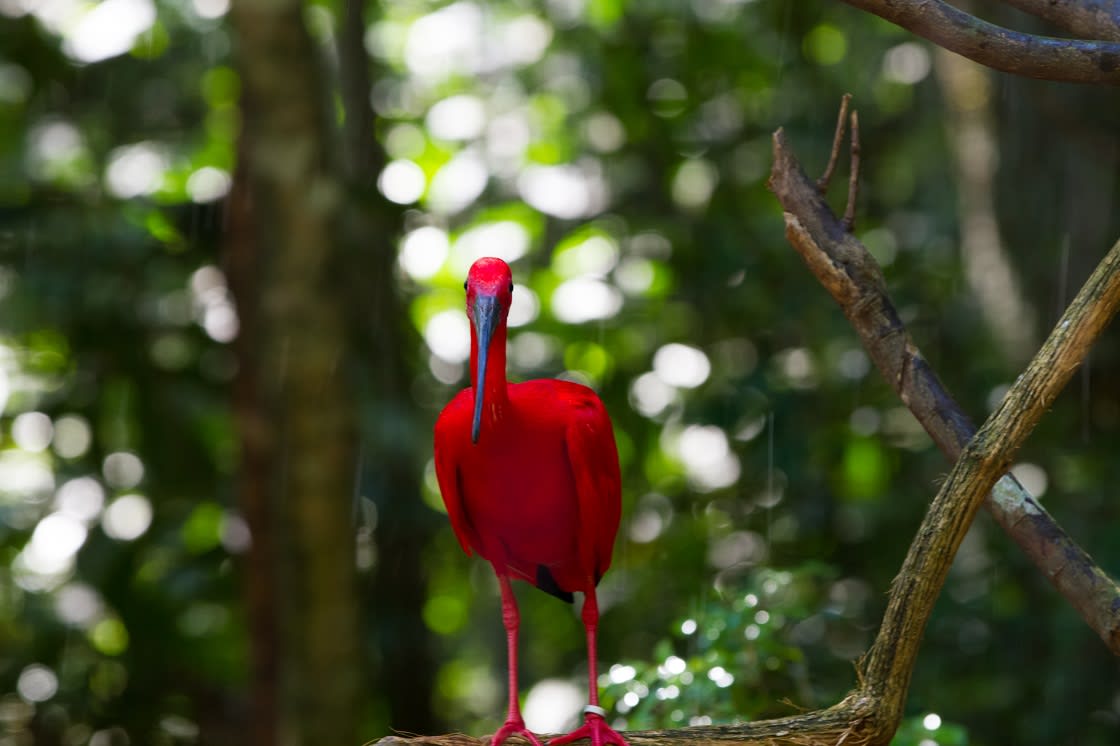
The Parque das Aves is a wildlife conservation bird park. Toucans, hummingbirds, and macaws, along with hundreds of other species, are viewed inside the atriums. A butterfly house and nature paths are also onsite. Most of the birds in the park are rescued from wildlife smugglers attempting to cross the border.
To catch a glimpse of even more wildlife than you saw in the national park, head to this animal refuge where you’ll find tons of birds, from toucans and parrots to eagles and owls. You’ll see a few Capuchin monkeys, anteaters, capybaras, and other native mammals inside. It’s a rescue center rather than a zoo, so most of the birds here were brought to be rehabilitated after being wounded in the park. Some will be released in the future, while some can no longer survive in the wild and live at the reserve. It is just three miles from the town and guides will take you on a tour to see the animals and tell you about the work they do here.

The Triple Frontier: Paraguay, Brasil & Argentina
Marco das Americas is where Argentina, Paraguay, and Brazil meet. It is the golden triangle. While standing on the viewing platform, you can witness the fork in the rivers Iguassu and Paraná meet. This is where all three countries come together.
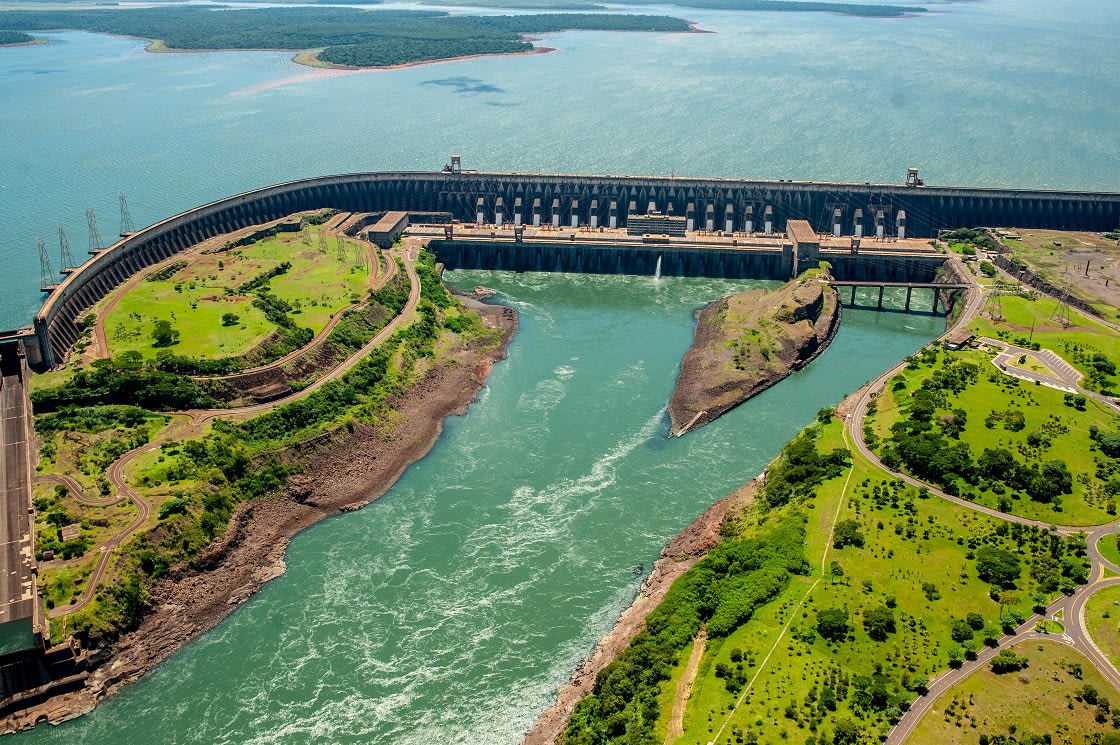
Itaipu Dam Shot From Above
It was once the largest hydroelectric dam in the world, the Itaipu Dam is now only second to China’s infamous Three Gorges. Here, a two-hour tour takes you into the facility where you see how the Iguassu River’s water is harnessed for energy. All three countries; Paraguay, Argentina and Brazil benefit from this hydroelectric dam.
The tour includes a documentary viewing that outlines the dam’s history and significance, as well as a trip to the external part of the dam, the front of the spillway, and finally a stop over the upper part of the dam. Keep your hard hat on for an elevator ride deep down into the power station and feel the heat generated by the surging water. After visiting the dam, the Itaipu Lake Sunset tour is a pleasant way to end your day, cruising in a catamaran to the center of the lake to enjoy what will hopefully be a dazzling sunset.
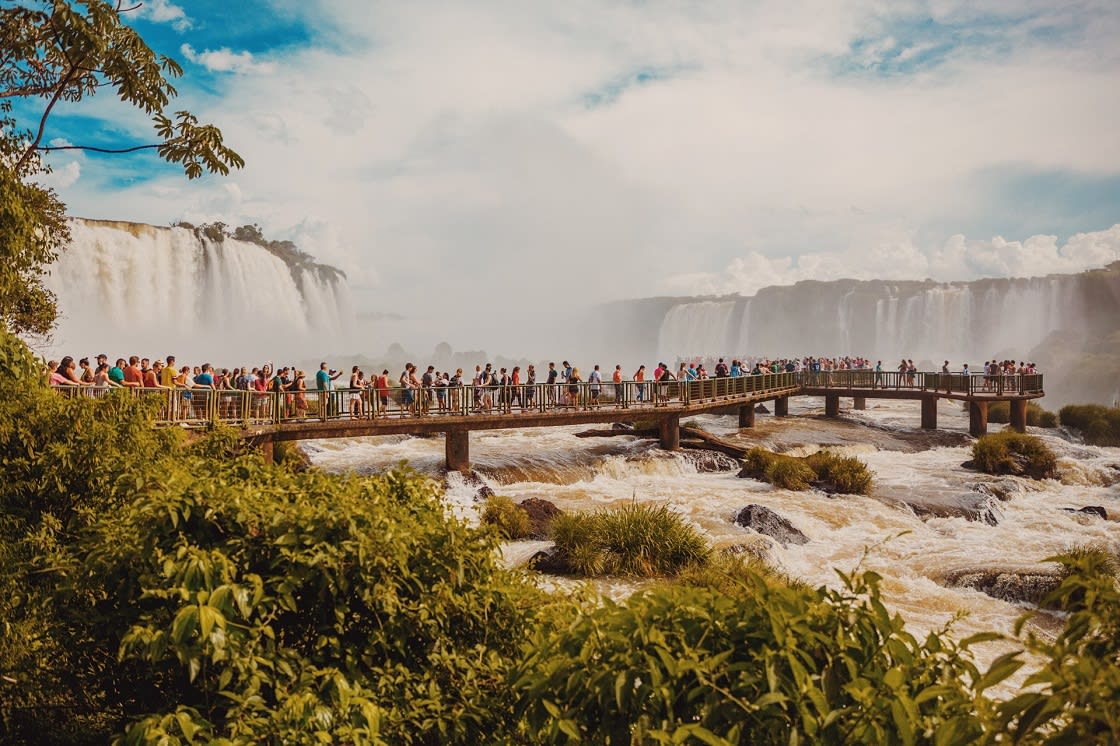
Catwalk
The best way to explore Iguazu Falls is to stay at least one night at the Belmond Hotel das Cataratas inside the park on the Brazilian side. It’s the only hotel in the National Park and by staying here, you have access to the trails along the falls and the catwalk leading into the horseshoe at sunrise and sunset.
Experience the thrill of a four-hour eco-adventure filled with trekking, ziplining, and rappelling in the dense forest known as Selva Misionera just outside the Argentinean town of Puerto Iguazu. View the rainforest’s huge range of fauna and flora, including over 400 species of birds and 2,000 varieties of plants. Trek deep into the forest, zipline through the jungle canopy and rappel down a canyon next to some dramatic waterfalls. After sweating your way through these thrilling adventures, jump in for a swim in a natural freshwater pool.
A nice idea for traveling families could be to join a guided tour of the rainforest and indigenous settlement at Comunidad Mbya Guaraní Yryapú, which is a community-based tourism project easily accessible from the city center of Puerto Iguazú. Here, you can learn about the customs of the Guaraní people and their way of living, while visiting the area where they grow vegetables and fruits. You’ll learn about the community’s history, religion, medicine, and language, and methods of hunting and survival. Funds raised by the tours go towards social and medical assistance, and you can purchase handicrafts including woven baskets, seed necklaces and bracelets, and wooden animals carved by local community members.
Starting from Puerto Iguazú, you can take a four-hour bike tour, which crosses one of the most bio-diverse and challenging environments in Argentina, the highly endangered Paranaense Rainforest. The route takes you along 25 miles of red soil tracks with spectacular downhills giving you views of the surrounding flora and fauna, which may include native jaguars and toucans. Shorter bike tours are also available.
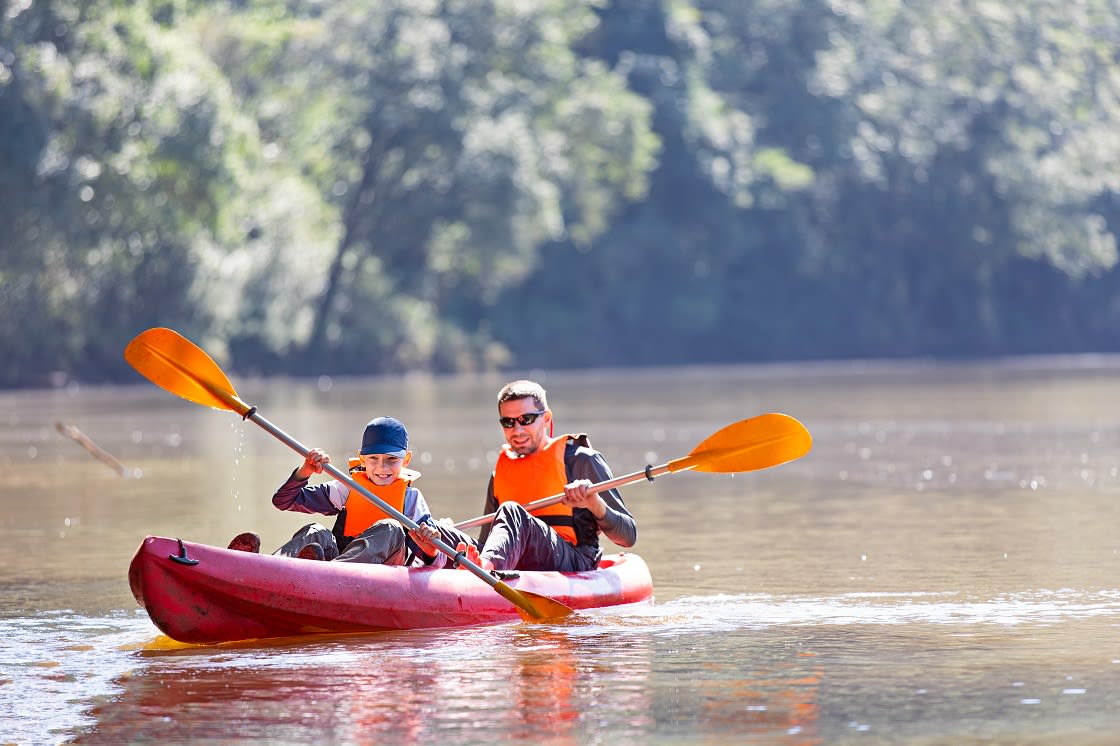
Father And Son Enjoying Kayaking
The Paraná is South America ́s second longest river after the Amazon and its name in guaraní language means “relative of the sea”. Kayaking trips start with a gentle paddle that takes you to one of the Paraná ́s affluents, the Urugua-í river. This smaller river, and its serene waters, is a perfect place to contemplate nature. A swim in the river can be enjoyed as there are no dangerous animals in its waters.
While Rainforest Cruises aim to provide accurate and up-to-date information, we make no representations as to the accuracy or completeness of any information herein or found by following any link on this site. Rainforest Cruises cannot and will not accept responsibility for any omissions or inaccuracies, or for any consequences arising therefrom, including any losses, injuries, or damages resulting from the display or use of this information.




